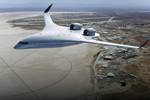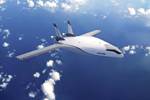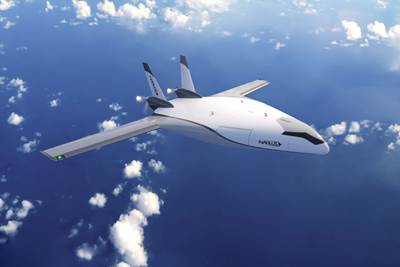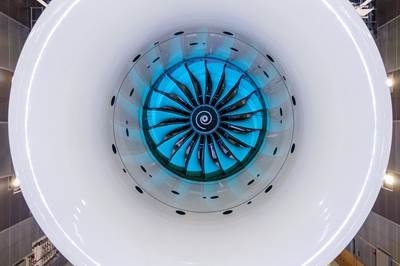Natilus announces Horizon blended wing body CFRP aircraft for 200-passenger narrowbody market
Following its Kona cargo aircraft with 460 pre-orders, this larger all-CFRP model responds to airlines’ request to fill Boeing and Airbus gap with 25% less weight, 40% greater capacity and 50% less carbon emissions, to enter service by early 2030s.
Rendering of the Horizon blended wing body (BWB) passenger aircraft being developed by Natilus. Source (All Images) | Natilus
Natilus (San Diego, Calif., U.S.) has announced launch of the Natilus Horizon blended wing body (BWB) aircraft, a step forward in sustainable commercial aviation for the underserved 200-passenger narrowbody market. Horizon will be the company’s second aircraft in production, following the 2028 entry into service (EIS) of its Kona unmanned cargo aircraft, which has 460 pre-orders. Horizon’s EIS is targeted for the early 2030s.
Natilus (pronounced NAW-tuh-luhs) was co-founded by Aleksey Matyushev and Anatoly Star in 2016 to develop the Kona aircraft, a BWB design for companies like UPS, FedEx and DHL to solve the problem of limited volume and high costs in traditional tube-and-wing cargo aircraft. Kona will now be joined by Horizon, a hyper-efficient BWB aircraft designed to be 25% lighter, provide 40% greater capacity and emit 50% less carbon than aircraft used in commercial aviation today. Both aircraft take advantage of Natilus’ mild BWB design featuring a slender lifting fuselage, high aspect ratio wings and twin aft-mounted engines.
Kona
Natilus’ inaugural aircraft, Kona, is an 85-foot wingspan, 19,000-pound aircraft — which means it can be certified per General Aviation guidelines — with a payload of 3.8 metric tons and a range of 900 nautical miles. Kona’s construction is 80% carbon fiber-reinforced polymer (CFRP) composite and 20% metal. The latter is used in Kona’s twin vertical tails and control surfaces, while the BWB fuselage will be CFRP. Kona will reportedly provide customers with double the cargo volume for each trip, while simultaneously reducing cargo transport cost by up to 60%.
Natilus announced in 2022 that it would partner with Janicki (Sedro-Wooley, Wash., U.S.) for composite part design and fabrication, citing the veteran composites tooling and technology supplier’s renowned reputation for innovation and quality workmanship. “We selected Janicki because they are a family-owned and operated company, founded and run by engineers with the highest qualifications and experience in designing large-scale, high-precision prototypes, tools and production parts,” says Natilus CEO Aleksey Matyushev.
Initial deliveries of Kona with twin Pratt & Whitney Canada (Longueuil, Quebec) PT6A-67D turboprops are expected in 2028. In April 2023, Natilus performed test flights with its sub-scale prototype and has recently completed its full-scale Kona prototype which will begin flight testing in 2025.
Horizon
Horizon is an BWB designed for the narrowbody market, accommodating up to 200 passengers and a payload of 25-28 metric tons on routes such as San Diego to Hawaii, Los Angeles to Boston, and New York to London. Its 118-foot wingspan will meet current limitations at airports, and though weight and payload will depend on the final configuration per customer and mission, the all-CFRP Horizon will deliver significant improvements thanks to the inherent aerodynamic and interior volume benefits of its BWB design.
In Aviation Week’s report by Guy Norris, Matyushev notes now is the right time to pursue Horizon because “the commercial aviation industry is looking for real solutions to become more sustainable, more efficient,and more profitable.” He adds that this timing “aligns with fleet purchasing decisions by commercial carriers to meet the airline industry’s 2050 net-zero goals.”
Next steps
While Natilus proceeds with certification and then first deliveries of Kona, it will also move forward with finalizing the design for Horizon. To meet the target of EIS in the early 2030s, this will need to happen quickly. “That’s 6-7 years away, but from our perspective, it’s not a lot of time,” Matyushev says. “So, we already have wind tunnel testing scheduled for next year, and toward the end of that, we have to freeze the design. Then we’ll start working on the internals, systems and manufacturing that will enable us to achieve our first flight goals.”
One strategy that will help is the use of already commercialized and available engines, landing gear, avionics and other systems — an approach Natilus is also using for Kona. And, as can be seen with Janicki, it is also working with trusted subcontractors.
The company also benefits from an experienced in-house team who have worked on more than 25 aircraft programs spanning commercial, military and general aviation and including innovators from General Atomics, Northrop Grumman, Skunkworks and SpaceX. It is also drawing on the knowledge of its customer partners, which include major airlines, lessors and integrators such as Ameriflight, a regional feeder airline for UPS, as well as Volatus Aerospace, Flexport, Astral, Aurora International, Dymond and others.
The company’s key investors — including Draper Associates, VU Venture Partners, Starburst Ventures, Mubadala, Seraph Group, New Climate Ventures, Soma Capital, Type One Ventures and Liquid 2 Ventures — are supporting this next step forward with Horizon. “We’ve been asked by key players in the market to do this,” says Matyushev, “and we finally realized this is the right time, which is exciting, but also challenging. We see that BWB aircraft have become more normalized and that the market needs new solutions. We’re trying to essentially take our design and put it together with existing materials, manufacturing and systems in a unique way that will provide the opportunities and efficiencies our customers want in the near-term.”
Related Content
Cryo-compressed hydrogen, the best solution for storage and refueling stations?
Cryomotive’s CRYOGAS solution claims the highest storage density, lowest refueling cost and widest operating range without H2 losses while using one-fifth the carbon fiber required in compressed gas tanks.
Read MoreThe potential for thermoplastic composite nacelles
Collins Aerospace draws on global team, decades of experience to demonstrate large, curved AFP and welded structures for the next generation of aircraft.
Read MorePlant tour: Middle River Aerostructure Systems, Baltimore, Md., U.S.
The historic Martin Aircraft factory is advancing digitized automation for more sustainable production of composite aerostructures.
Read MoreASCEND program update: Designing next-gen, high-rate auto and aerospace composites
GKN Aerospace, McLaren Automotive and U.K.-based partners share goals and progress aiming at high-rate, Industry 4.0-enabled, sustainable materials and processes.
Read MoreRead Next
JetZero accelerates BWB airliner development with $235 million Air Force award
The commercial/military composite aircraft design will offer a 50% reduction in fuel burn and emissions with potential for future conversions to hydrogen.
Read MoreNatilus partners with Janicki for blended wing autonomous aircraft
The Tier 1 supplier will design, fabricate and provide quality assurance of primary composite structures for the Natilus N3.8T prototype, to be used for air freight transport.
Read MoreComposites-intensive UltraFan aeroengine achieves full power milestone
Rolls-Royce full power engine test with sustainable fuel set to deliver efficiency improvements in aviation for future narrowbody and widebody aircraft.
Read More





























